11 Best Flies For Stocked Trout In Any Season 2024
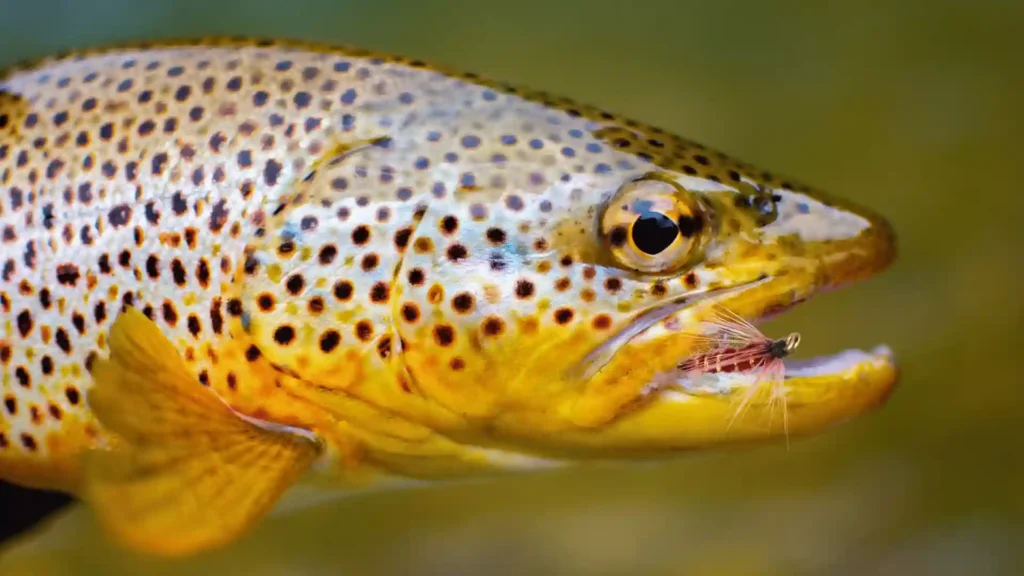
Did you know that stocked trout can be really choosy about what they eat? Knowing the best flies to use can make a huge difference in how many fish you catch! Stocked trout can be fussy, so having the right trout flies is super important for getting them to bite.
In this article, we’ll talk about the top fly patterns that work great for catching stocked trout. Whether you’re new to fishing or you’ve been doing it for a while, knowing the best flies can help you catch more fish.
So, lets dive in.
Must Read: An In-depth Guide on Fly Fishing Tippet
10 Best Flies for Stocked Trout That You Should Have
When it comes to fishing for stocked trout, having the right flies in your tackle box can make all the difference. In this section, I will provide you with some additional fly selection tips to help you increase your chances of success on the water.
These flies have proven to be highly effective in enticing strikes from stocked trout and should always be included in your fly box:
1. Woolly Bugger
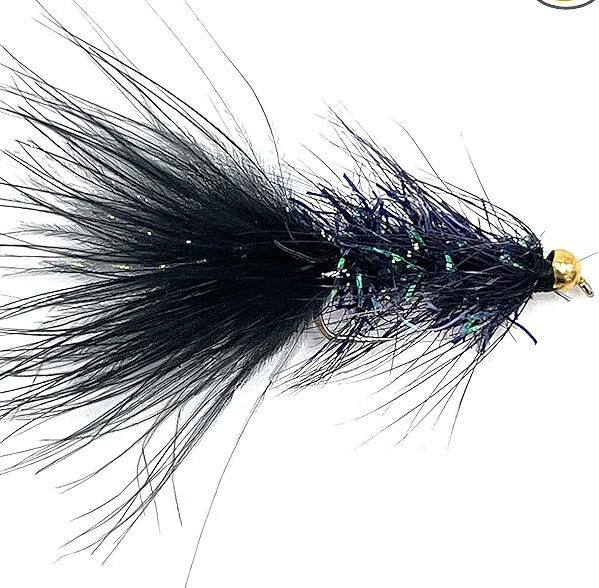
The Woolly Bugger is a versatile fly that resembles a small baitfish or leech. Its marabou tail and chenille body make it irresistible to trout.
It’s great for imitating a variety of underwater creatures and works well in different water conditions.
Key Features
- Ideal for catching rainbows in larger rivers.
- Quickly covers a large area of water, especially in deep currents.
- Black woolly bugger with chartruese trigger works well in both clean and turbid water.
2. Pheasant Tail Nymph
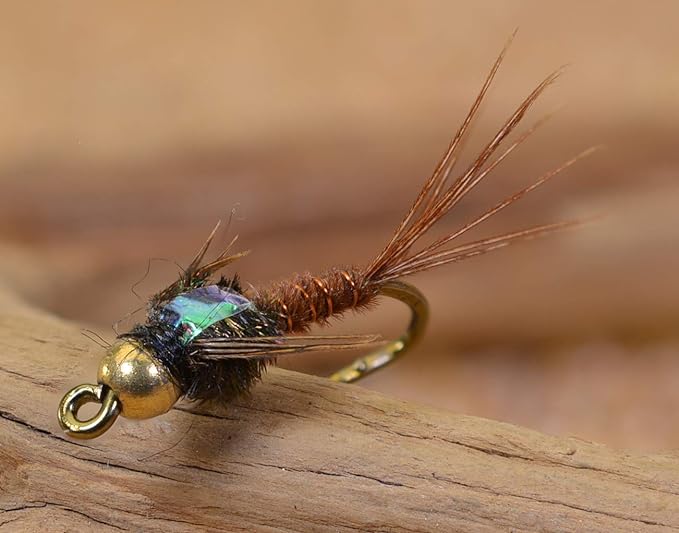
This fly mimics the aquatic insects that trout love to feed on. It’s tied with pheasant tail fibers for the body, with a thin wire ribbing and a peacock herl thorax.
It’s an effective pattern for fishing in slower-moving water and is a staple in many anglers’ fly boxes.
Key Features
- Classic pattern imitating mayfly nymphs and other aquatic insects.
- Body made of pheasant tail fibers with peacock herl thorax.
- Slender profile and subtle coloring for matching the hatch.
3. San Juan Worm
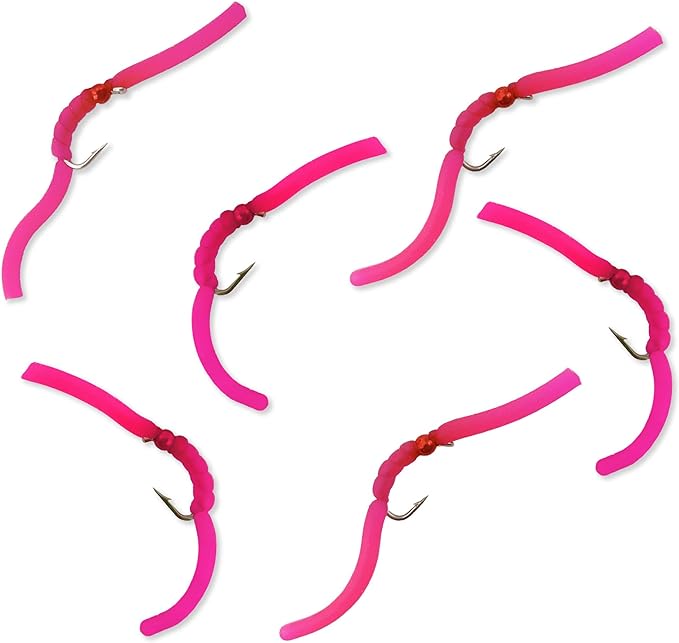
The San Juan Worm is a simple yet effective fly made to imitate aquatic worms found in rivers and streams. It’s typically tied with chenille or other soft materials in bright colors like red or pink.
It’s a go-to choice when trout are feeding near the river bottom, especially after rain when worms are washed into the water.
Key Features
- Simple yet deadly pattern imitating aquatic worms.
- Tied with chenille in colors like red, pink, or brown.
- Highly effective after rain or during high water conditions.
4. Adams Parachute

The Adams Parachute is a classic dry fly pattern that imitates a variety of mayflies and other small insects that trout feed on at the water’s surface. Its parachute-style hackle makes it highly visible and provides excellent floatation.
It’s a reliable choice for fishing during mayfly hatches or when trout are rising to feed on the surface.
Key Features
- Versatile dry fly pattern imitating mayflies and other insects.
- Features upright wing made from white calf hair for visibility.
- Body composed of dubbed fur with grizzly hackle parachute-style.
5. Griffith’s Gnat
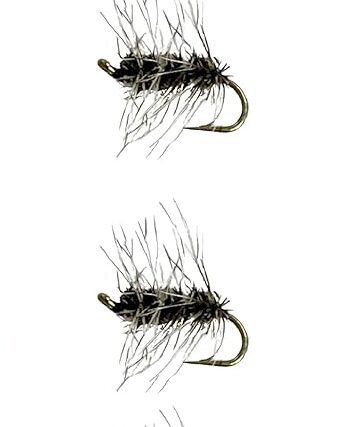
Griffith’s Gnat is a tiny fly that imitates clusters of small midges or gnats. It’s tied with a sparse body of peacock herl and a grizzly hackle wrapped around a thread or tinsel body.
This fly is excellent for fishing in calm waters or when trout are selectively feeding on tiny insects. It’s a must-have in any trout angler’s arsenal, especially on challenging days when fish are being picky.
Key Features
- Diminutive pattern mimicking small midges and tiny insects.
- Sparse body with peacock herl or dubbed fur.
- Bushy hackle wound around the body for effectiveness during midge hatches.
6. Rockerka (CDC Beetle)
The Rockerka, also known as the CDC Beetle, is a beetle imitation fly that utilizes CDC (Cul de Canard) feathers for its buoyancy and natural appearance. It imitates the terrestrial insects that often fall into the water, attracting trout.
Its profile resembles a beetle struggling on the water’s surface, making it irresistible to feeding fish, especially during the warmer months.
- Versatile pattern imitating terrestrial insects.
- Effective even without surface fish activity.
- Ideal for various fishing conditions.
7. Roe Egg
The Roe Egg lure is a winner when it comes to catching stocked trout. Whether you use it alone or with a woolly bugger, it’s effective. You can drift it along a current or let it sit in a lake—either way, it’s great for fooling early season trout.
Stocked trout are drawn to fluorescent colors, but here’s a tip: mimic their hatchery diet. Most hatchery trout eat brown pelletized food similar in size and shape to a Roe Egg. Just color the egg with a brown marker to make a perfect match.
While most egg patterns are light, jig head eggs are useful for covering different water depths. Use them in lakes with a stimulator dry fly as an indicator, or drift them in streams through deeper areas.
Key Features
- Roe Egg lure is irresistible to trout.
- Resembles food fed to hatchery trout.
- Effective in rivers and lakes.
- Ideal for subtle fishing approaches.
8. Mop Fly
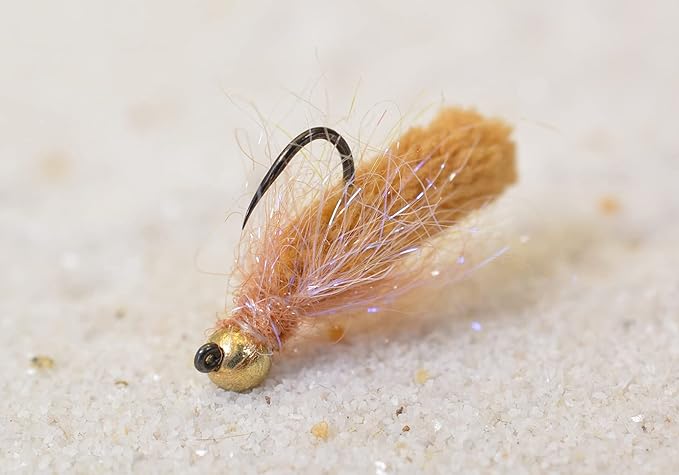
The Mop Fly is a controversial yet highly effective pattern made from short segments of microfiber chenille that resemble the appearance of a mop.
Despite its simple design, it mimics various aquatic organisms, such as scuds or worms, and can be especially effective in murky or high-water conditions. Some anglers swear by its effectiveness, while others debate its ethical implications.
Key Features
- Controversial yet successful fly from the US.
- Used effectively by the US junior team in competitions.
- Bright colors like chartreuse and orange are preferred.
- Heavy flies stay longer in the water column for better results.
9. Prince Nymph
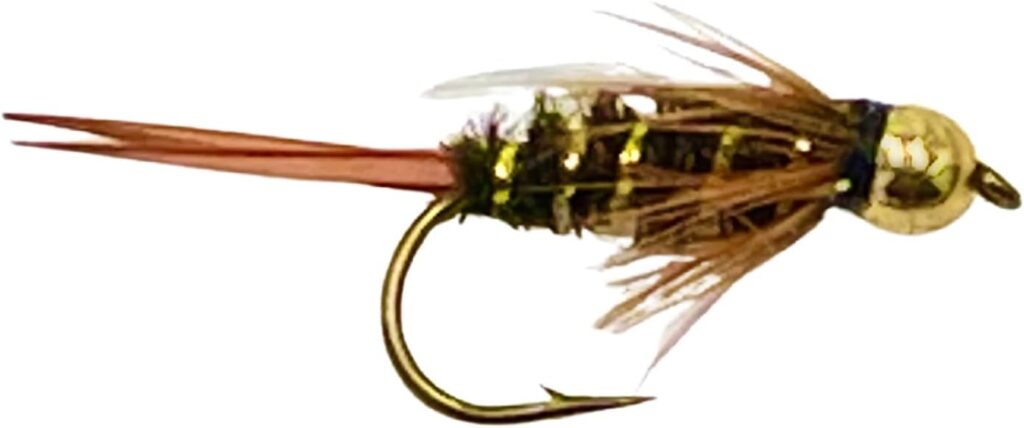
The Prince Nymph is a classic attractor pattern that imitates a variety of aquatic insects, including stonefly nymphs and mayfly nymphs.
It typically features a bead head, a peacock herl body, and white or brown goose biot wings, along with some strands of peacock herl for a tail.
Its flashy appearance and natural profile make it a staple in many trout flies boxes.
10. Elk Hair Caddis
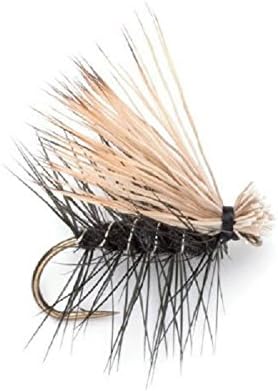
The Elk Hair Caddis is a versatile dry fly pattern that imitates adult caddisflies. Its buoyant elk hair wing and palmered hackle make it float well on the water’s surface, resembling a caddisfly in its resting position.
It’s an effective pattern for fishing during caddisfly hatches, and its silhouette makes it easy for trout to spot, especially in riffles and fast-moving water.
Key Features
- Palmered hackle
- Buoyant elk hair wing
- Versatile and effective
11. Hare’s Ear Nymph

The Hare’s Ear Nymph is a classic nymph pattern that imitates a wide range of aquatic insects, including mayfly nymphs and caddisfly larvae.
It’s typically tied with a body made from hare’s ear dubbing, a rib of copper wire for segmentation, and a soft hackle collar.
Its natural colors and buggy appearance make it effective in almost any trout stream, especially when fished near the river bottom where nymphs are active.
Key Features
- Natural hare’s ear dubbing
- Copper wire ribbing
- Effective subsurface imitation
10 Fly Fishing Tips for Stocked Trout
When it comes to fly fishing for stocked trout, having the right techniques and strategies is essential for a successful outing.
Whether you’re a beginner or a seasoned angler, these 10 tips will help you improve your fly-fishing game and increase your chances of landing trophy trout.
TIP 1: Proper Fly Selection
Selecting the right flies for stocked trout is crucial. Consider using stocked trout flies patterns such as nymphs, dry flies, and streamers.
It’s important to have a variety of trout flies in your arsenal to match the different insect hatches and conditions.
TIP 2: Understand Stocked Trout Behavior
Stocked trout behave differently from wild trout. They are accustomed to feeding on pellet food and have adapted to life in hatcheries.
Knowing their behavior patterns will help you position yourself correctly and increase your chances of a successful catch.
TIP 3: Identify Prime Locations
Stocked trout tend to congregate in certain areas of a stream or pond. Look for deep pools, undercut banks, and areas with structure.
These areas provide cover and food sources for the trout, making them prime locations for targeting stocked fish.
TIP 4: Vary Your Retrieval Techniques
Experiment with different retrieval techniques to entice stocked trout. Try using a slow, steady retrieve or an erratic, twitchy retrieve to mimic the movements of natural prey.
Varying your retrieve can trigger a strike when the trout is hesitant to bite.
TIP 5: Pay Attention to Fly Presentation
The presentation of your fly is crucial for enticing stocked trout. Make sure your cast is accurate and your fly lands softly on the water.
Avoid drag by using mending techniques to maintain a natural drift. Pay attention to the direction of the current and adjust your presentation accordingly.
TIP 6: Use Attractive Colors
Stocked trout are often attracted to bright and flashy colors. Consider using flies in vibrant shades such as chartreuse, orange, and pink.
Experiment with different color combinations to see which ones trigger the most strikes.
TIP 7: Fish During Optimal Times
Stocked trout are most active during certain times of the day. Early morning and late afternoon are typically prime feeding periods.
However, depending on the weather and water conditions, trout may also feed throughout the day. Pay attention to these feeding windows for the best chances of success.
TIP 8: Adapt to Changing Conditions
Weather, water temperature, and insect hatches can greatly impact stocked trout behavior. Be flexible and adapt your fly selection and fishing techniques accordingly.
Pay attention to the conditions on the day of your fishing trip and adjust your approach for optimal results.
TIP 9: Practice Proper Catch and Release
When catching stocked trout, it’s important to handle the fish with care. Wet your hands before handling the trout to avoid damaging their protective slime layer.
Use barbless hooks or crimp the barbs down to minimize injury to the fish. Practice proper catch and release techniques to ensure the trout’s survival.
TIP 10: Keep Learning and Exploring
Lastly, never stop learning and exploring new fly fishing techniques. Attend workshops, read books, and connect with fellow fly anglers to expand your knowledge and skills.
The more techniques you master, the better prepared you’ll be to catch stocked trout in different scenarios.
Recommended: How To Fish Emerger For Trout Fishing
When Nymphing is Best – Favorite Nymphs
In my experience, nymphing is often the most effective technique when targeting stocked trout. These fish are typically accustomed to feeding underwater, making nymphs a popular choice among fly fishermen.
Nymphs imitate’s the aquatic insects that trout feed on, making them irresistible to these eager predators.
When it comes to nymph selection, it’s important to choose patterns that closely resemble the insects found in the water.
It’s always a good idea to carry a variety of nymphs in different colors and sizes to match the hatch and increase your chances of success.
“By imitating the insects that stocked trout feed on, nymphs can be highly effective in triggering their predatory instincts and enticing them to strike.”
When fishing with nymphs, it’s crucial to pay attention to your presentation. Cast upstream and allow the nymph to drift naturally with the current, mimicking the behavior of a real insect.
Keep an eye on your line for any subtle movements or twitches, indicating a potential strike. Proper nymphing techniques combined with the right fly selection can greatly improve your success rate when targeting stocked trout.
Remember, the best nymphs for stocked trout vary depending on the specific body of water and the time of year.
It’s always a good idea to consult with local fly shops or fellow anglers familiar with the area to get the most up-to-date information on effective nymph patterns.
These areas often have slightly warmer water temperatures due to groundwater sources or runoff, making them attractive feeding grounds for hungry trout.
When fishing in winter, it’s essential to approach these holding spots cautiously. Trout are more sluggish during cold temperatures, so avoid spooking them with loud noises or sudden movements.
Must Read: History of Fly Fishing
When Streamers Are Best For Trout Fishing
When it comes to targeting stocked trout, streamer fishing can be highly effective, especially in specific conditions or when targeting larger fish.
In this section, I will discuss when and how to use streamers, as well as recommend some productive patterns that have proven successful.
Streamer flies are designed to imitate small baitfish, leeches, or other aquatic creatures that trout prey upon.
They are typically larger and heavier than other fly patterns, making them ideal for covering more water and enticing aggressive strikes.
Final Words
In summary, having the right flies is super important for catching stocked trout. Using the best flies mentioned here can really help you catch big trout.
Whether you pick dry flies, nymphs, or streamers, it’s important to change your tactics based on the weather and try different things.
When you’re going after stocked trout, it’s important to be ready with lots of different flies. The 10 Fly Fishing Tips for Stocked Trout we talked about can help you get even better at fishing and catch more fish.
Make sure you have your favorite nymph patterns ready, as they usually work well and help you get better at nymphing.
Also, using a dry fly with a nymph attached can make a big difference when fishing for stocked trout. Having a nymph below your dry fly can make the trout more likely to bite.
Knowing when to use streamers is also important for catching big stocked trout. Picking the right streamer flies and using the right techniques can really help you catch more fish.
FAQS
What flies work best for catching stocked trout?
The top flies for stocked trout mimic their usual food. Woolly Buggers, San Juan Worms, Pheasant Tail Nymphs, and Adams Parachute Dry Flies are popular choices. These flies have a track record of luring stocked trout to bite.
What fly patterns catch stocked trout effectively?
Egg Patterns, Prince Nymphs, Zebra Midges, Griffith’s Gnats, and Elk Hair Caddis are effective patterns. These flies copy insects and baitfish that stocked trout eat, increasing your chances of getting their attention.
How do I pick the right fly for stocked trout?
Consider the conditions like water temperature and clarity, plus the time of year and food available. Have a mix of flies in different sizes and types. Experiment until you find what trout like best.
Should I use dry flies or nymphs for stocked trout?
Both can work. Dry flies copy insects on the water, while nymphs mimic those underwater. Use dry flies if trout are feeding on the surface and nymphs if they’re not rising.
How do I present my flies to stocked trout?
Cast upstream and let your fly drift naturally with the current or sink to the right depth. Avoid sudden movements. Watch for signs of interest and adjust your presentation accordingly.
What streamer patterns are good for stocked trout?
Woolly Buggers, Muddler Minnows, Clouser Minnows, and Zoo Cougars are recommended. Streamers work well for larger trout or in murky water, triggering aggressive strikes.
What flies should I have in my box for stocked trout fishing?
Include a mix of nymphs, dry flies, streamers, and attractor patterns. Pheasant Tail Nymphs, Adams Parachute Dry Flies, Woolly Buggers, San Juan Worms, and Elk Hair Caddis are must-haves. A diverse selection helps you adapt to different conditions and trout preferences

Meet Ibrahim Khan, an avid angler and author in Fishing Teach. He shares his wealth of knowledge from his 16 years of experiences in fishing. His articles are a captivating blend of practical insights and thrilling tales that invite readers into the enchanting world of fishing.
Ibrahim’s guides are your go-to guide in the realm of fishing on this informational site. Hailing from a coastal paradise, Ibrahim’s passion for angling is the heartbeat of his life.
